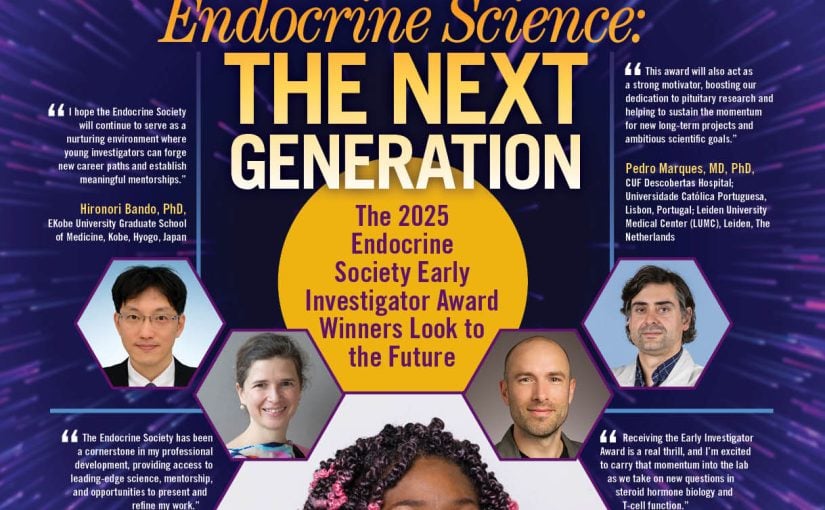
While I think every issue of Endocrine News is intriguing, this month’s issue really piqued my interest because it focuses on the atypical and unusual: rare endocrine diseases. From Cushing’s syndrome to hypoparathyroidism and more, we’ve endeavored to include as many endocrine disorders as possible that might tend to be “off the beaten path,” so to speak.
Senior Editor Derek Bagley takes us back to San Francisco for a look at the intriguing session stemming from the Endocrine Society journal JCEM Case Reports where there were a “String of Pearls” presented during ENDO 2025. Make that a string of clinical pearls: unusual cases that often stymie endocrine clinicians but were presented with intrigue as well as solutions for those in attendance. “In the third annual Clinical Pearls from JCEM Case Reports the attendees heard presentations from early-career aspiring endocrinologists on the management of Cushing disease in pregnancy, the presentation and management of metastatic choriocarcinoma-related paraneoplastic thyroid storm, and the management of hypophosphatemic osteomalacia,” says JCEM CR Editor-in-Chief William F. Young, Jr., MD. “Each case presentation was followed by a content expert who put the topic into a broader context and expounded on the key pearls that clinicians should take away from the session.”

Kelly Horvath takes us on a journey of “Unintended Consequences” as we look at the history of growth hormone and how it impacted protein-misfolding diseases so many years ago. Originally presented in the pages of the Journal of the Endocrine Society, Kelly talked to Alan Rogol, MD, PhD, about exceedingly rare cases of Creutzfeldt-Jakob disease and Alzheimer disease that occurred when human growth hormone was first administered. Much of the mystery has evolved via treatment with growth hormone extracted from cadavers, the only method available in the middle of the previous century. But as Rogol explains, there was an overwhelming need and not enough sources for human growth hormone, so researchers turned to using material from cattle. “It was such a problem that I did my PhD dissertation 55 years ago on the structure of bovine growth hormone because we thought that its active cores might work in humans, which of course seems unrealistic in retrospect,” Rogol says. I’m sure you’ll be enthralled as I was when you read this fascinating tale.
Derek takes us on another trip back to San Francisco and ENDO 2025 for an examination of new data presented there regarding Cushing’s syndrome and one of its pharmacological treatments, osilodrostat. In “Staying in Control,” Derek talks to Richard Auchus, MD, PhD, who discusses the results from the LINC rollover study on the long-term safety and effectiveness of osilodrostat in patients with Cushing’s disease, which was well-tolerated during extended use. “It turns out that we learned a lot from LINC 3 and we were able to titrate the medication more safely by taking our time and using fewer steps, because the drug is so potent, we didn’t really have to go up very high in most people,” Auchus says. “Based on the information we learned from LINC 3, we conducted LINC 4 very effectively and really showed a tremendous difference.”
From Cushing’s syndrome to hypoparathyroidism and more, we’ve endeavored to include as many endocrine disorders as possible that might tend to be “off the beaten path,” so to speak.
Derek takes a deep dive with a look at a new pharmaceutical treatment for hypoparathyroidism in “Following Up,” where he talks to Aliya Khan, MD, who recently served with several other Endocrine Society members on a consensus statement writing group regarding treatment guidelines for this rare disorder. Specifically, palopegteriparatide which was approved by the U.S. Food and Drug Administration in August 2024 to treat adults with hypoparathyroidism, a malady that is so rare that it only impacts about 0.1% to 0.3% of the population, with the most common cause occurring in 1% to 2% of those undergoing thyroid surgery. Regarding the timing of the consensus statement, Khan says “we felt that we needed to do this because now we actually have an approved drug for hypoparathyroidism, and we wanted to provide information as to when to use it, how to use it, how to start therapy, how to manage therapy.”
Despite the array of cases presented in this issue, we barely scratched the surface! Let us know what you think about this issue and if there are any recommendations for future rare cases we should cover, let us know. You can always reach me at: [email protected].

